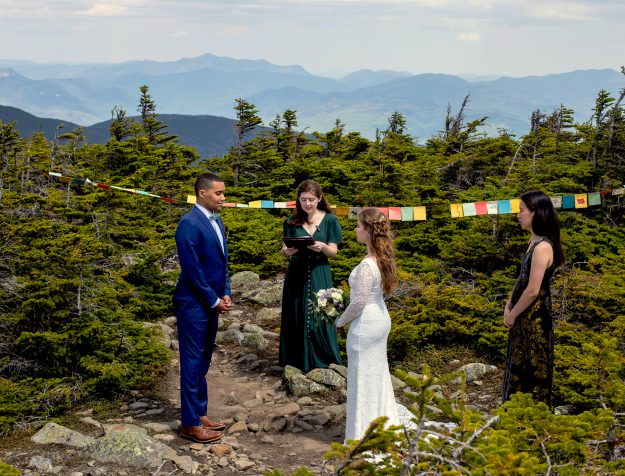When two friends asked me to officiate at their wedding, I said yes immediately. I was excited and honored by the invitation to play a part in the ceremony of a couple I’ve admired since our college days in New Hampshire. He was raised Buddhist, and they are both meditators, so even though their ceremony would be mostly secular they wanted to include the dharma in some form. My role—besides getting ordained online and signing the marriage license—would be to guide the ceremony and bring a spiritual element to it. Like any millennial, I quickly turned to Google for guidance but was disappointed when I found that the Internet had little advice to offer first-time Buddhist wedding officiants. This was too important a responsibility to approach without guidance, so I sought out veteran officiants from a variety of Buddhist traditions.
It turns out that wedding ceremonies aren’t a traditional part of the Buddhist minister’s job, and Buddhist temples aren’t traditional wedding venues. Perhaps this shouldn’t be surprising in a tradition that prizes celibate monasticism, and whose founder left his own marriage to pursue a spiritual path. Marriage has been a secular matter for most of Buddhist history, though some couples do seek a blessing from monks. Reverend Patti Nakai, resident minister of the Buddhist Temple of Chicago, a Shin Buddhist sangha, remarked that “a [Buddhist] wedding is nothing special” and “the wedding ceremony is just a public acknowledgment of the couple’s bond.”
Without a standard ceremony, weddings in Buddhist countries have drawn on local cultures and rituals. As Buddhism has spread across the globe, couples and organizations have created new traditions combining Buddhist elements with secular or spiritual ones. For example, the Buddhist Churches of America (BCA), a Shin Buddhist organization founded by Japanese immigrants in the early 19th century, has developed a wedding liturgy with elements of Japanese and American Christian weddings.
In the last 10 to 15 years, BCA ministers have noticed wedding locations shifting away from temples or churches toward secular venues, with friends and family members presiding instead of clergy, BCA Bishop Reverend Marvin Harada said. But at the Shunkoin Zen Temple in Kyoto, Japan—the first Zen temple in the country to marry same-sex couples—Reverend Takafumi Kawakami has noticed a different trend: many non-Buddhist couples now host destination weddings at Buddhist temples.
Buddhist weddings are an evolving ritual, a product of the tradition’s journey across continents.
Physical location aside, the art of officiating is itself “a place of practice” for Zen priest Sensei Koshin Paley Ellison, co-founder of the New York Zen Center for Contemplative Care and the officiant at two dozen weddings over 11 years. He advises officiants to stay grounded in their practice and says he finds it helpful to slow down and check in with his body before beginning the planning process. Taking a deep breath, he reminds himself, “This is not about you.”
The experts emphasize that the officiant should have conversations with the couple to get a thorough sense of their relationship, values, religious background, and aspirations for the wedding. Koshin asks couples “what their partner makes them feel inside themselves” and builds the ceremony from the conversation sparked by his question.

Readings and rituals are often a vexing open question. Rev. Nakai recommends that couples offer tea to each other and to their parents—a wedding custom from China—to “recognize the partner’s karmic connections” and show awareness of how “all are part of a net of interdependent lives.” If a parent is deceased, she recommends displaying a photo of them and offering flowers.
Zen practitioner Alex Tzelnic, who was married in a ceremony “with a splash of dharma” and later officiated at a Buddhist wedding himself, stresses attention to practical elements during and after the ceremony. He recommends that officiants take the couple aside for a few minutes before the ceremony “to connect and decompress before taking center stage,” as was done for him and his wife. Tzelnic’s biggest piece of advice? “Make sure the audience can hear you”—a lesson he learned the hard way—and remember when speaking in front of the group that “you’ll never be in front of a friendlier crowd. . . . It’s your very own hand-selected, codependent web of origination.”
As for my friends, we’ve planned a mix of Buddhist, Christian, and secular rituals for their intimate spring wedding, which will be streamed from a mountaintop in New Hampshire. I’ll start by leading a guided meditation to set the tone and will then share some thoughts about their relationship. Against a backdrop of prayer flags, the couple will exchange rings and vows they have written themselves. After hiking back down to family and friends, they’ll hold two secular rituals: a candle-lighting ceremony to symbolize unity and the creation of a time capsule.
The seasoned officiants who offered their advice taught me that Buddhist weddings are an evolving ritual, a product of the tradition’s journey across countries and continents. Since the American Buddhist wedding is still a new production, if the couple is comfortable with a less traditional affair, go ahead and get creative. Just don’t forget to submit the marriage license when you’re done!
Editor’s note: The wedding took place in May 2021; photo below.

A selection of Buddhist wedding rituals new and old
San San Kudo: A Japanese tradition where by the couple sips of a cup of sake and often offers sake to their parents, symbolizing unity and family ties. A similar Chinese tradition features tea.
Read or chant the Heart Sutra: This important Mahayana text can be a good addition to a traditional wedding.
Offer the sixteen bodhisattva vows: This Zen tradition puts one’s commitment to selfless service and ethical precepts front and center.
Chant the triple refuge and offer incense: American Shin Buddhist couples take refuge in the Buddha, dharma, and sangha shortly after exchanging vows and rings.
Read Buddhist poetry or passages selected by the couple.